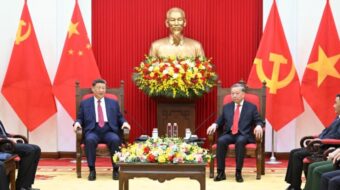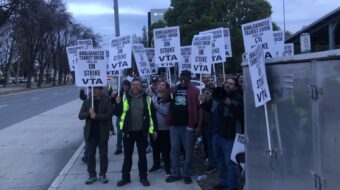
On September 17, 1989, 98 United Mine Workers of America members and a minister occupied the Pittston Coal Company’s Moss 3 preparation plant in Carbon, Virginia, the most important act of civil disobedience during the Pittston strike.
In April of that year mine workers began their historic strike against Pittston Coal. Richard Trumka, then president of the United Mine Workers (UMWA), sent Cecil Roberts, now president of the UMWA to lead the effort. The strike lasted from April 5, 1989 to February 20, 1990.
Pittston terminated health care benefits for approximately 1,500 retirees, widows, and disabled miners. The company refused to contribute to the benefit trust established in 1950 for miners who retired before 1974 and refused to bargain in good faith.
The strike affected production in mines mostly in Virginia, but a few in West Virginia and Kentucky as well. Mine workers and their families engaged in acts of civil disobedience, work stoppage, protests, and rallies. The “Daughters of Mother Jones” were initially involved in the strike because of their husbands. They went into action immediately, forming an informational picket line during the 14-month period before the strike that the miners worked without contract. Had it not been for the efforts of the Daughters, an early picket line would not have been possible as the men were still working.
Mine workers, other union members, community groups, people of faith, women’s groups and students of all races and nationalities came from all over the country, and the world, to establish Camp Solidarity.
Over 2,000 miners were at Camp Solidarity and some 40,000 joined the protest.
Pittson’s production dropped by two thirds during the campaign.
The most important act of civil disobedience during the Pittston strike was Moss 3. UMW leaders selected 99 union members out of Virginia, West Virginia, and Kentucky to participate. Moss 3 was set up to be an unexpected mass, nonviolent, sit down strike within the preparation plant. The 99 strikers walked into the plant peacefully and sat down inside the plant to halt production. Meanwhile, thousands of other supporters gathered outside the plant to encourage the strikers inside – an estimated 5,000 supporters at the height of Moss 3 were gathered outside the production plant.
The sit down strike inside Moss 3 lasted from Sunday to Wednesday. After four days, the strikers felt they made their point to Pittston and walked out.
People’s World (then a print edition) reporters Denise Winebrenner Edwards and Scott Marshall were the only media representatives to be invited by the strikers to cover the occupation story. Miners and the People’s World have a long and intertwined history.
Wikipedia and Roberta Wood contributed to this article.
Photo: United Mine Workers Journal, 2009, Pittston 20 years later Special Commemorative Issue.











